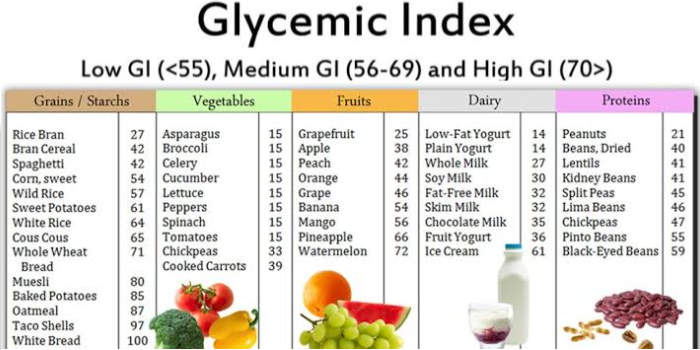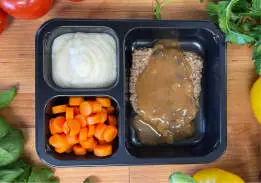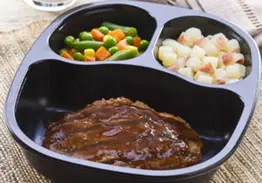Low-Glycemic Index Foods Help Control Blood Sugar

If your favorite football teams are in a showdown to win the championship, and you’re not there to watch it live, what are you going to do? Check the score as often as you can. It’s the best way to keep tabs on how your team is doing. Hopefully, it’s a win. Right?
If you want to win at keeping your blood sugar levels under control, check the score when you eat food using the Glycemic Index Guide. Everything you eat has a Glycemic Index Score. It’s a simple way to measure how fast carbohydrates in food are digested and raise blood sugar levels.
You should avoid or limit foods with a high Glycemic Index score like white bread, candy bars, and sugary drinks, because they’ll cause rapid spikes in blood sugar levels, which you don’t want.
What is the Glycemic Index and Why it Matters
Foods on this list with a low Glycemic Index score, like whole grains, carrots, beans, or grapefruit, take longer to digest and help prevent rapid fluctuations in blood sugar levels. This low Glycemic index food list can help you control your blood sugar level and they should make up most of your diet when you have diabetes.
Here’s what to look for when you’re choosing foods based on the Glycemic Index Guide:
- Low-Glycemic Index foods: Score less than 55
- Medium-Glycemic Index foods: Score 56 to 69
- High-Glycemic Index foods: Score 70 or higher
- For more information on glycemic index and glycemic load including food rankings, visit the Glycemic Index Research and GI News website.
If you think it’s too much work to evaluate everything you
eat based on the Glycemic Index, you’re not alone. It takes
a little practice to get used to recognizing foods that have a low
or medium Glycemic Index score.
Fortunately,
there’s an easier way. Our
Diabetic-Friendly meals, made with fresh ingredients, are made with foods that have a
low or medium Glycemic Index score. That means all you have to do
is pick your favorites, heat in the microwave, and enjoy.
How to Build a Low-GI Plate
If you’re trying to keep your blood sugar steady, it starts with what you put on your plate. Swapping out blood sugar spikers for low glycemic foods isn’t just smart—it’s easier than you may think. This simple shift can help with blood sugar control, improve energy, and support a balanced diet. The best part: you’re not giving up flavor or comfort. You’re just eating for a steadier, healthier you.
The glycemic index, or GI, is a ranking system. It measures how fast certain foods make your blood sugar rise after eating. Foods with a low glycemic score (think beans, non-starchy veggies, and whole grains) digest slowly and keep blood sugar stable. High-GI foods like white bread or sugary drinks cause a quick spike and then a crash.
Why Low-GI Plates Matter for Everyone
Anyone can benefit from low-GI eating. But if you live with diabetes, want to manage your weight, or just want more energy, this approach pays off in big ways. By sticking with slow-digesting foods, you keep those wild sugar swings at bay. Stable energy means fewer cravings and better focus, too.
If you’re searching for healthy eating and nutrition, this method fits right in. The benefits of balanced diets become clear when your plate is full of the right foods. Low-GI eating works well with low-sodium meal plans and can be adapted for people on renal diets or seeking healthy meal delivery options.
Building Your Low-GI Plate: The Basics

Photo by
Canto Photography
When you’re ready to build a meal that supports blood sugar control, here are some steps that make it simple:
- Fill half your plate with non-starchy vegetables. Think spinach, broccoli, bell peppers, or zucchini. They’re low in sugar, high in fiber, and pack loads of vitamins.
- Add a portion of lean protein. Chicken breast, eggs, tofu, or salmon all digest slowly and keep you feeling full longer.
- Choose whole grains or starchy veggies for one quarter. Brown rice, quinoa, sweet potatoes, or lentils offer lasting energy with a low-to-moderate GI.
- Finish with a healthy fat. A few slices of avocado, a drizzle of olive oil, or a sprinkle of nuts lets you feel satisfied without spiking your blood sugar.
Here’s a sample plate layout for easy reference:
| Food Group | Options to Try | Role |
|---|---|---|
| Non-Starchy Veg | Broccoli, carrots, leafy greens | Fill half the plate, add fiber |
| Lean Protein | Eggs, turkey, tofu, salmon | 1/4 of plate, steady energy |
| Whole Grain/Starch | Quinoa, lentils, sweet potato | 1/4 of plate, complex carbs |
| Healthy Fat | Avocado, walnuts, olive oil | Add satisfaction, slow digestion |
Want a list of great options? Browse these LGI foods for blood sugar control to kickstart your next shopping trip.
Everyday Low-GI Meal Ideas
Simple doesn’t mean boring. Try these practical and healthy recipes that make low-GI eating fun and flavor-packed:
- Scrambled eggs, sautéed spinach, and black beans for breakfast
- Grilled chicken, quinoa, and a mixed veggie salad with olive oil for lunch
- Lentil soup with roasted sweet potatoes and steamed broccoli for dinner
If you need easy dinner ideas or want to skip the chopping, pre-prepared frozen meals or healthy meals for seniors can be a game-changer. These ready-made options save time, especially for busy professionals or new parents.
Flexible Eating for Special Diets
Low-GI isn’t a one-size-fits-all thing. You can adapt it for gluten-free, dairy-free, or renal diet needs. There are plenty of meals for diabetics and even kid-friendly meals that help everyone in your household eat well.
If you want the best meal delivery services that offer weight loss-friendly meals, keep an eye out for companies that list the GI of their entrées. MagicKitchen.com, for example, has options that cut the guesswork, making balanced eating more doable for everyone.
Practical Tips for Success
Sticking with any new routine can be tough, but a few strategies make all the difference:
- Plan in advance. Use a meal prep guide for beginners, especially if you’re just starting out with low-GI eating.
- Batch cook and freeze meals. Learn how to freeze meals effectively so you always have healthy choices on hand.
- Stock up on top meal prep containers. Good kitchen organization makes healthy eating less stressful.
- Mix it up. Try new recipes. Let every week bring a fresh set of flavors or quick cooking hacks.
Eating For Blood Sugar Control
Eating for blood sugar control doesn’t have to mean bland meals or confusing rules. Focusing on low glycemic foods helps you take charge of your health, whether you’re managing a condition, helping your family, or just aiming for more energy. Build your plate with colorful, whole foods, add time-saving touches, and you’ll reap the benefits in every bite.
Hungry for more options? Check out these foods to maintain healthy blood sugar levels and discover how simple changes can spark better health. Healthy eating is always within reach—one plate at a time.



 INSURANCE CUSTOMERS CLICK HERE!
INSURANCE CUSTOMERS CLICK HERE!






